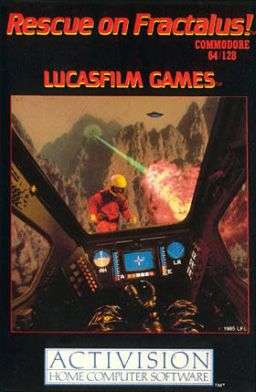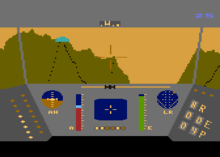Rescue on Fractalus!
Rescue On Fractalus! is a March 1984[2] first-person shooter[1] computer game created by Lucasfilm Games (later LucasArts Entertainment). It was originally released for the Atari 8-bit family and the Atari 5200 games console. It was also ported to other popular platforms of the day, such as the Apple II, ZX Spectrum (by Dalali Software Ltd), Amstrad CPC, Tandy Color Computer 3 and Commodore 64. The game was one of the first two products from the fledgling Lucasfilm Computer Division Games Group led by Peter Langston. David Fox was the project leader and designer. Music was mainly composed by Charlie Kellner.[3]
| Rescue on Fractalus! | |
|---|---|
 European Commodore 64/128 cover | |
| Developer(s) | Lucasfilm Games |
| Publisher(s) | Epyx Activision Atari Corporation |
| Director(s) | David Fox |
| Designer(s) | David Fox Loren Carpenter Peter Langston Charlie Kellner Gary Winnick |
| Platform(s) | Atari 8-bit, Atari 5200, Amstrad CPC, Apple II, Commodore 64, Color Computer 3, ZX Spectrum |
| Release | March 1984 |
| Genre(s) | Action, first-person shooter[1] |
| Mode(s) | Single-player |

Gameplay
Flying
The game uses fractal technology to create the craggy mountains of an alien planet,[4] where the visilibility was drastically reduced by the dense atmosphere. The player controls a fictional "Valkyrie" space fighter[5] (converted for search and rescue duty) from a first-person view, attempting to land and pick up downed Ethercorps pilots.[6] Some of these mountains hold anti-aircraft guns,[7] which have to be avoided or destroyed. Due to the varied terrain, the direction finder has to be used to locate the pilots, whose visual beacons are often masked by mountain ridges.
At higher levels, the enemy Jaggis begin flying kamikaze saucers. The mission area also moves into day/night boundaries. Night missions are particularly difficult, requiring diligent use of the altimeter to avoid crashing.[8]
Flying consumes fuel. The way to replenish this supply is to rescue downed pilots who bring their remaining fuel supplies on board.
The thick atmosphere is sufficiently acidic that downed pilots' craft are being slowly disintegrated. An exposed pilot's survival time outside his craft is less than a minute, due to his flight suit and helmet literally dissolving. This makes it imperative that the player rescue pilots as quickly and efficiently as possible.
Rescue
After landing within sufficient "walking" proximity to the pilot, the player shuts down the engine, also turning off the ship's shields.[9] Turning on the engines prematurely would incinerate the exposed pilot and the shields would prevent him from entering the ship.[10] The downed pilot then disembarks his crashed ship, runs down to the Valkyrie's cockpit, and knocks on the crew entry door; the player can then open up and let the pilot in to complete the rescue. Failing to open the door kills the pilot; his knocking on the hatch becomes at first frantic, then slower and more feeble as he perishes in the corrosive environment. Sometimes the pilot found is an Ace Pilot, indicated visually by their purple helmet. These are worth ten times the score awarded for a normal pilot to the player.[11]
As a twist on this relatively straightforward premise, added at the suggestion of George Lucas,[12][13] some of the "pilots in distress" are actually hostile aliens in disguise; this twist was kept out of the game's manual and marketing.[14] After landing near a downed pilot, the player watches him run off-screen, and then has to wait for several tense seconds—if it were human, the familiar, frantic "tap-tap" noise would be heard from the ship's hatch; otherwise, the alien Jaggi would suddenly jump back into view, sans helmet, roaring and trying to smash into the cockpit. Unless the player restores the ship's shields, the windscreen cracks open and the pilot is killed. Likewise, inadvertently letting a Jaggi pilot into the player's ship has disastrous results — it begins to dismantle the ship. In early levels, the Jaggi can be distinguished by their green heads versus the white human helmets. However, in later levels the aliens evidently learn to don the human helmet and become identical in appearance. This, along with an unpredictable pause between the human/alien approach and the tap-tap/alien jump makes for a very tense experience. According to head developer David Fox, this shock moment made Rescue on Fractalus! "the first computer game to really scare people".[12]
Reception
Computer Gaming World stated that Fractulus and Ballblazer "are slightly weak in the finer points of game design, but ... set a new standard for arcade-style games that will set out future expectations".[15] In 1996, the magazine named Rescue on Fractalus! the 82nd best game ever, with the editors remarking that "many keep old computers around just to play it."[16] Commodore User thought the game was "nothing special" and said it "provides reasonable, if unchanging, gameplay with a good flight simulator, but it lacks something, probably a proper identity."[17] Zzap!64 were impressed by the game, awarding it a score of 91%. They said that it was an excellent shoot-em-up.[18]
Trivia
During development, Rescue on Fractalus! was named Behind Jaggi Lines!. This name refers both to the Jaggis, the fictional race of hostile aliens in the game, as well as the lack of spatial anti-aliasing in the game's graphics, resulting in jagged diagonal (or curved) lines, colloquially known as "jaggies".[12] The squiggles visible on the Jaggi's suit when it attacks are actually the initials of the development team rotated by 90 degrees; Atari at the time famously barred developers from having their name displayed in games.[19]
A poster of the game appears in Zak McKracken and the Alien Mindbenders.[20]
The original developers of Rescue on Fractalus wanted the game to be set in Star Wars universe but were not allowed to do so by George Lucas[21]
Unreleased Atari 7800 version
In 2004, an unreleased prototype of Rescue on Fractalus! for the Atari 7800 was found in the possession of its original programmers. While most of the core elements of the game were intact, the project was cancelled before the gameplay could be completed.[22]
Legacy
LucasArts and Factor 5 began work on a sequel titled Return to Fractalus for the Amiga in the late 1980s, however it was decided that the hardware couldn't handle the concept being worked on. An Amiga port of Rescue On Fractalus to be published by Rainbow Arts was announced in a February 1991 issue of The One, but was never released.[23] By 1994, Factor 5 believed that the current generation of 3D consoles had the technology the Fractalus sequel required and again began work on the game. Eventually, the work on game was converted to Star Wars: Rogue Squadron for the Nintendo 64 instead.[24]
See also
References
- Weiss, Brett (April 4, 2011). Classic Home Video Games, 1972–1984: A Complete Reference Guide. McFarland & Co. p. 147.
- "LucasArts Entertainment Company | 20th Anniversary". Web.archive.org. 2006-04-28. Archived from the original on 28 April 2006. Retrieved 2016-07-08.
- "Lucasfilm And Atari". Atarimagazines.com. 1982-06-06. Retrieved 2016-07-08.
- https://www.atarimagazines.com/compute/issue64/review_rescue.php
- "Atari Age scan of original game manual". atariage.com. p. 11.
- "Atari 5200 Manuals — Rescue on Fractalus (Atari)". AtariAge. p. 2. Retrieved 2016-07-08.
- https://www.atarimagazines.com/compute/issue64/review_rescue.php
- https://www.atarimagazines.com/compute/issue64/review_rescue.php
- "Atari 5200 Manuals — Rescue on Fractalus (Atari)". AtariAge. p. 4. Retrieved 2016-07-08.
- "Atari 5200 Manuals — Rescue on Fractalus (Atari)". AtariAge. p. 7. Retrieved 2016-07-08.
- "Atari 5200 Manuals — Rescue on Fractalus (Atari)". AtariAge. p. 9. Retrieved 2016-07-08.
- Hague, James (1997). "Halcyon Days: Interviews with Classic Computer and Video Game Programmers".
- GameSpot, "Classic Studio Postmortem: Lucasfilm Games", David Fox, 24 March 2014, accessed 03 April 2015
- an 🔌 🚙, David Fox, in (27 December 2018). "It was George Lucas' idea that sometimes the pilot you're rescuing turns out to be an alien. We figured out how to make that happen, and got Atari to agree to keep it a complete secret in their marketing/box/manual text".
- Williams, Gregg (June–July 1985). "Lucasfilm Enters Home Gaming". Computer Gaming World. p. 22.
- Staff (November 1996). "150 Best (and 50 Worst) Games of All Time". Computer Gaming World (148): 63–65, 68, 72, 74, 76, 78, 80, 84, 88, 90, 94, 98.
- "View a Scan". www.zzap64.co.uk.
- "ZZap!64 Magazine Issue 005". Archive.org. Retrieved 2016-07-08.
- an 🔌 🚙, David Fox, in (27 December 2018). "We weren't allowed (by Atari) to have our names in credits on any of the screens, so we found ways around that. Fun Easter Egg:pic.twitter.com/POVDu9eGh0". External link in
|title=(help) - Youtube, "Amiga Longplay: Zak McKracken and the Alien Mindbenders", adalsgaard, 11 January 2014, accessed 3 April 2015
- https://www.polygon.com/2014/3/20/5530942/lucasfilm-games-vets-look-back-on-the-earliest-days-of-george-lucas
- "AtariProtos.com page on RoF for Atari 7800". Retrieved 2007-11-26.
- "Fractal Feature". The One. No. 29. emap Images. February 1991. p. 12.
- Thorpe, Nick (June 2017). "The History of... Star Wars Rogue Squadron". Retro Gamer. Vol. 168. Future. p. 20.
External links
- Rescue on Fractalus! at MobyGames
- Rescue on Fractalus! at Atari Mania
- Rescue on Fractalus! at SpectrumComputing.co.uk
- Personal history from Peter Langston (January 2005)
- Rescue on Fractalus at Reminiscing: Atari 8-bit Games
- Video from the 1984 Lucasfilm press conference introducing Rescue on Fractalus!